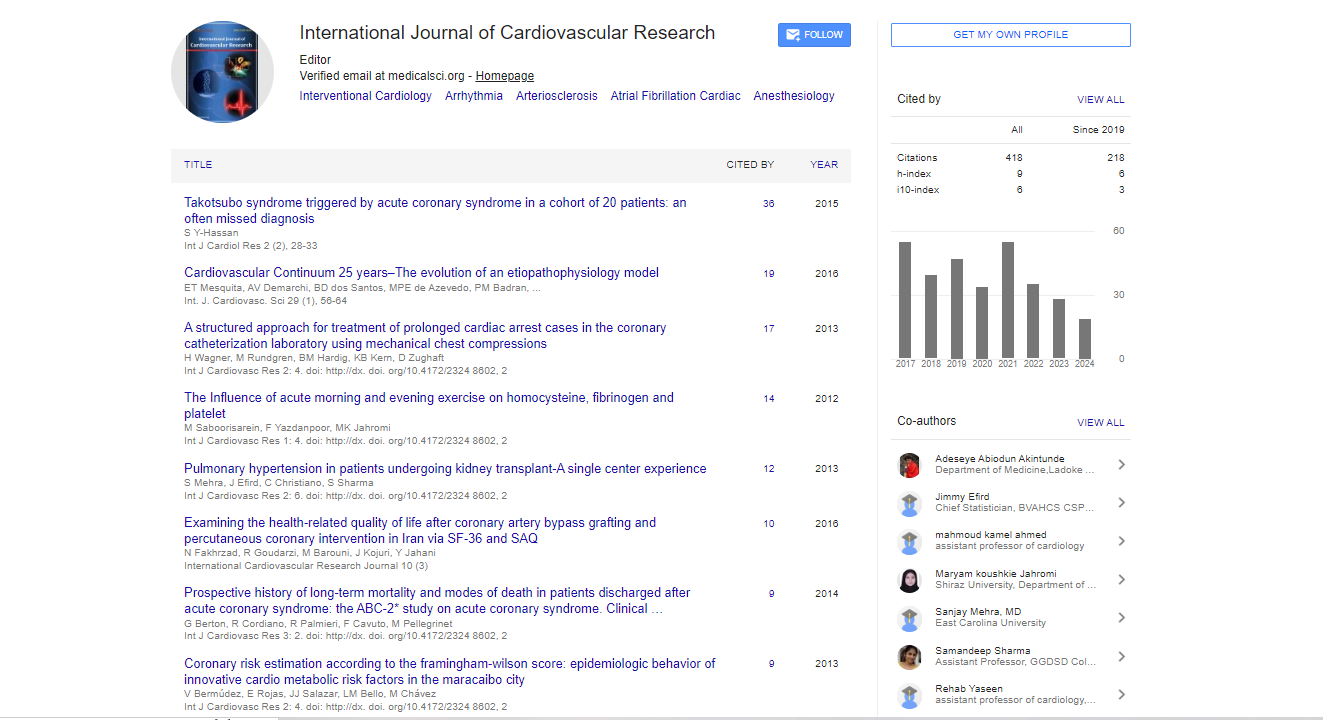Commentary, Int J Cardiol Res Vol: 13 Issue: 4
Innovations in Heart Failure Management: Advancing Patient Care and Outcomes
Lucy Evans*
1Department of Cardiology, Imperial College London, London, United Kingdom
*Corresponding Author: Lucy Evans,
Department of Cardiology, Imperial College
London, London, United Kingdom
E-mail: lucy.evans@imperial.ac.uk
Received date: 15 July, 2024 Manuscript No. ICRJ-24-149305;
Editor assigned date: 17 July, 2024, PreQC No. ICRJ-24-149305(PQ);
Reviewed date: 31 July, 2024, QC No. ICRJ-24-149305;
Revised date: 07 August, 2024, Manuscript No. ICRJ-24-149305(R);
Published date: 14 August, 2024, DOI: 10.4172/2324-8602.1000578
Citation: Evans L (2024) Innovations in Heart Failure Management: Advancing Patient Care and Outcomes. Int J Cardiol Res 13:4.
Description
Heart Failure (HF) remains a major global health burden, affecting over 64 million individuals worldwide. It is a progressive condition characterized by the heart’s inability to pump blood effectively, leading to a range of debilitating symptoms such as shortness of breath, fluid retention and fatigue. While significant advancements have been made in the management of HF, mortality rates remain high and the demand for innovative approaches to improve patient outcomes is paramount. Heart failure is a multifaceted syndrome with various underlying etiologies, including ischemic heart disease, hypertension, cardiomyopathies and valvular heart diseases. Its clinical presentation varies widely, with two primary classifications: Heart Failure with reduced Ejection Fraction (HFrEF) and Heart Failure with preserved Ejection Fraction (HFpEF). HFrEF is characterized by a weakened heart muscle and reduced pumping ability, whereas HFpEF involves stiffened heart muscles that impair the heart's capacity to fill with blood. Given the heterogeneity of HF, treatment approaches have evolved to include more personalized and targeted therapies.
The treatment for heart failure has dramatically changed over the past decade, particularly with the introduction of novel pharmacological agents. The basis of HF therapy has historically involved angiotensin-converting enzyme inhibitors (ACEIs), Angiotensin II Receptor Blockers (ARBs), beta-blockers and Mineralocorticoid Receptor Antagonists (MRAs). However, new classes of drugs have been developed that specifically target the pathophysiological mechanisms of HF, offering improved outcomes for patients. Angiotensin Receptor-Neprilysin Inhibitors (ARNIs) are represented by sacubitril/valsartan, have revolutionized HFrEF management. This combination therapy blocks the detrimental effects of the Renin-Angiotensin-Aldosterone System (RAAS) while augmenting the beneficial effects of natriuretic peptides.
Sodium-Glucose Cotransporter-2 (SGLT2) inhibitors have shown remarkable benefits in HF management. These drugs promote diuresis and natriuresis while reducing preload and afterload on the heart. Moreover, emerging evidence suggests that these drugs may also benefit patients with HFpEF. In addition to pharmacological advances, significant progress has been made in the development of medical devices that target the mechanical and electrical dysfunctions in HF. These devices have proven to be life-saving interventions for patients with advanced HF or those refractory to medical therapy. Implantable Cardioverter-Defibrillators (ICDs) and Cardiac Resynchronization Therapy (CRT) devices have long been established as standard treatments for patients with HF and reduced ejection fraction. ICDs prevent sudden cardiac death by detecting and terminating lifethreatening arrhythmias, while CRT improves ventricular synchrony, reducing symptoms and improving survival in selected patients. Recent technological improvements, including leadless pacemakers and Magnetic Resonance Imaging (MRI) compatible devices, have enhanced the safety and efficacy of these treatments. Left Ventricular Assist Devices (LVADs) mechanically assist the heart in pumping blood, providing relief from end-stage HF symptoms and improving quality of life. The newer generation of LVADs, such as the HeartMate 3, has demonstrated better durability, fewer thrombotic complications and improved survival rates compared to earlier models. Baroreflex Activation Therapy (BAT) is an emerging neuromodulation technique that targets the baroreceptors in the carotid artery to reduce sympathetic nervous system activation, which plays a key role in HF progression. BAT has been shown to improve symptoms, exercise capacity and quality of life in HF patients, particularly those with high levels of sympathetic overactivity.
The advent of digital health tools has opened new possibilities for heart failure management, enabling early detection of clinical deterioration and facilitating timely interventions. Remote monitoring, telemedicine and Artificial Intelligence (AI)-driven technologies are reshaping the delivery of care and improving patient outcomes. Wearable sensors and implantable hemodynamic monitoring systems, such as the CardioMEMS device, allow for real-time monitoring of pulmonary artery pressures in HF patients. These devices provide early warning signs of worsening HF, enabling clinicians to adjust treatment before symptoms appear. Studies have shown that remote monitoring can reduce hospitalizations, improve patient adherence and optimize medical management. The COVID-19 pandemic accelerated the adoption of telemedicine in HF care. Virtual consultations, remote patient monitoring and digital health platforms have become integral to managing chronic HF patients, especially.
Conclusion
Heart Failure (HF) represents a significant global health challenge, impacting the lives of over 64 million individuals worldwide. As a complex and progressive syndrome, it manifests through a diverse array of symptoms that severely compromise patients' quality of life. Despite notable advancements in treatment strategies, the persistently high mortality rates underscore the urgent need for innovative approaches to enhance patient outcomes. Understanding the multifactorial nature of HF is essential, as it encompasses various underlying conditions such as ischemic heart disease, hypertension, cardiomyopathies and valvular heart diseases. The differentiation between Heart Failure with reduced Ejection Fraction (HFrEF) and Heart Failure with preserved Ejection Fraction (HFpEF) highlights the necessity for tailored therapeutic interventions. As the field continues to evolve, a shift towards more personalized and targeted treatment modalities is essential to address the unique clinical presentations and underlying mechanisms of heart failure.
 Spanish
Spanish  Chinese
Chinese  Russian
Russian  German
German  French
French  Japanese
Japanese  Portuguese
Portuguese  Hindi
Hindi 



